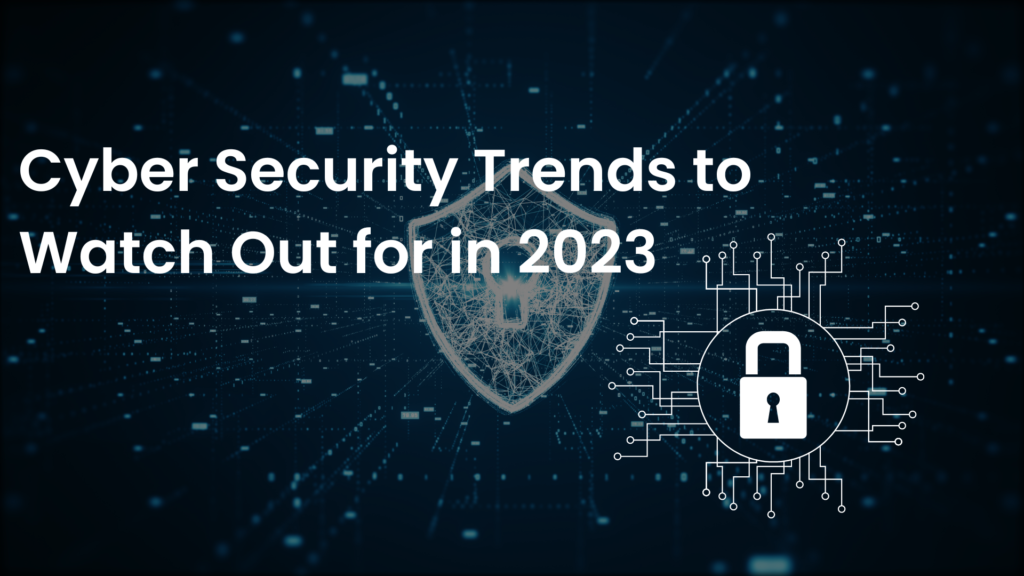CXO
UPDATES
Cyber Security Trends to Watch Out for in 2023
Although keeping up with cybersecurity risks has always been difficult, the rate at which new threats are emerging today is concerning. Given the skill of cyber attackers and the abundance of security measures, the issues facing today’s security business could be characterised as a perfect storm, with a growing attack surface caused by remote working and cloud usage. This dynamic may produce disjointed insights and data, which would exacerbate the security skills gap already in place.

The way security teams approach threat detection and response is evolving. Organisations want broad visibility, integrated data, and the capability to act quickly in order to protect themselves against sophisticated attacks and securely manage the digital revolution.The average overall cost of data breaches in India increased by more than 3X from INR 53.5 million in 2012 to INR 176.0 million in 2022, according to the Cost of Data Breach Report 2022. Finding and containing these breaches takes longer.
Additionally, 5G will make it possible for more devices to connect quickly, which will put additional demand on security monitoring techniques to be updated. Cybersecurity will play a significant part in the scaling of AI and hybrid clouds, which has never been done before. These trends indicate that enterprises must improve their digital defences to fend off the scope and severity of cyberattacks in a nation like India, which is undergoing an exponential digital transition. Businesses must fortify and continuously enhance their digital defences if they want India to advance technologically. Here are a few trends in cyber security to be aware of in 2023.
Essential Infrastructure Displaying "Blind Trust":
In essence, the epidemic has altered critical infrastructure. The globe has relied on manufacturing more than ever in the last two years, yet maintaining production was difficult. In fact, almost one-fourth of compromised critical infrastructure organisations experienced a ransomware or destructive attack, according to the Cost of Data Breach study 2022, at a time when various nations’ cyber authorities are advocating increased awareness to these sectors. Organisations must adopt a Zero Trust architecture that only grants access to verified and identifiable individuals in place of their current approaches to conventional cybersecurity.
Hybrid Cloud Security:
Organisations must establish comprehensive security measures regardless of where the data resides—on-premises, in public or private clouds, or at the edge.In order to protect data in 2023, enterprises must adopt comprehensive security plans, regardless of whether the data is on-premises, in public or private clouds, or at the edge. The hybrid multi cloud journey must take security into account at every stop. Adapting security strategies for multiple clouds, introducing new tools and unproven technologies, sharing responsibility and third-party risks, an expanding threat landscape, dissolving perimeters, siloed visibility of threats, securing sensitive data and managing access, as well as increased risks of misconfigurations and compliance monitoring, are important issues that must be addressed as part of hybrid cloud architecture.
Quantum-safety needs to be taken seriously:
As quantum computing develops and poses potential concerns, such as the ability to swiftly crack encryption algorithms and access sensitive data, businesses will become more and more interested in quantum-safe cryptography and security to safeguard their data from being altered, hacked, or manipulated.
Automation and Artificial Intelligence Are Increasing Defenders:
Organisations with fully adopted security AI and automation save $3.05 million per data breach, according to IBM’s most recent Cost of a Data Breach Report. The difference in average breach costs is 65.2%. A growing number of businesses are implementing AI-powered automation to boost productivity, gain economies of scale, and enhance threat management. As time goes on, AI and automation will be a crucial part of this new security scenario.
Integration of XDR and Zero Trust Strategies is necessary:
Organisations may modernise security operations and embrace digital transformation by combining Zero Trust and XDR policies. By adjusting dynamically to people, datasets, and workloads across the enterprise, regardless of where they are, security will become a business enabler.
Attack surface management and offensive security will perform the role of a trusted adversary for customers:
The constant identification, inventory, classification, and monitoring of an enterprise’s IT infrastructure is mission vital due to the exponential expansion of exposure points in hybrid cloud operating environments brought on by remote and hybrid working patterns. In fact, according to ESG data, 67% of businesses experienced an increase in their external attack surface during the past two years, and 69% of those businesses were penetrated.
Bring the attacker’s perspective into the security operation centre, continuously detect externally facing assets that are visible to attackers on-premises or in the cloud, and give top priority to exposures that represent the most risk.
Gain awareness of insider dangers as they will be increasing:
It is widely accepted that internal risks have a greater financial impact than external ones. The cost of an insider threat occurrence is significantly impacted by the length of time it takes to identify and contain an insider threat.
Organisations can use various technical and non-technical controls to enhance identification and prevention of each type of insider threat. Security teams must distinguish between the symptoms presented by each sort of insider threat.
Also the attackers’ perspective in security operations is crucial. Security teams, however, can take a proactive approach to insider threat defence by comprehending the motives of attackers.
Successful firms take thorough measures to reduce insider threats. They could make use of security programmes that: accessible data for maps ,creates trust mechanisms for access authorization, access revocation, and multifactor authentication (MFA) establishes guidelines for devices and data storage keeps an eye out for dangers and dangerous behaviour action as required.